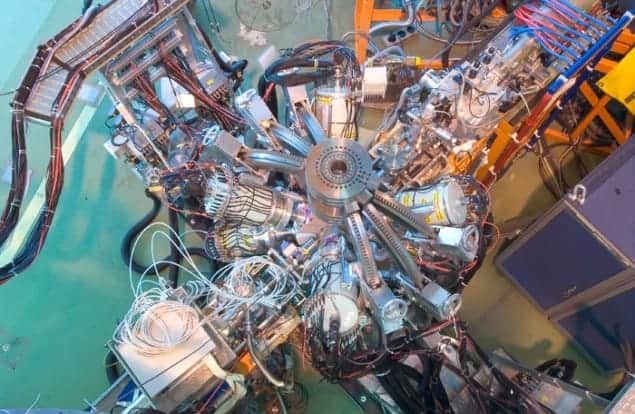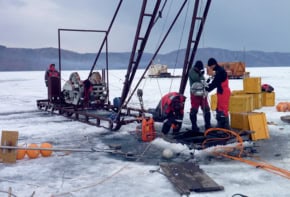
An international team of physicists has found the best evidence yet that some heavy nuclei are not spherical or ellipsoidal – but “pear-shaped”. The researchers found clear signs of this lopsidedness in two particular nuclei – radon-220 and radium-224 – that were created by smashing protons into a uranium carbide target at the REX-ISOLDE facility at CERN. As well as providing new information about the forces that bind protons and neutrons together in nuclei, the discovery could also help shed light on physics beyond the Standard Model of particle physics.
Physicists have known for decades that nuclei can occur in different shapes beyond simple spheres. In most cases, these non-spherical nuclei look either like a rugby or American football, or like a discus – both these shapes having axial and reflection symmetries. Any departure from a sphere is usually described by a “quadrupole deformation”, driven by underlying “quadrupole” interactions between the nucleons (protons and neutrons) in the nucleus. However, physicists have also suspected that there are even more subtle “octupole” interactions between nucleons, which would be expected to cause some nuclei to be pear-shaped – or even resemble a pyramid.
Although there was some limited evidence for pear-shaped nuclei in experiments carried out on radium-226 and neodynium-148 in the 1990s, neither study was conclusive. What Peter Butler of the University of Liverpool and colleagues in Belgium, Finland, Germany, Poland, Spain, Switzerland, the UK and the US have now done is to find strong evidence for octupole transitions in radon-220 and radium-224. These transitions are a sign that the nuclei are lopsided and appear in the spectrum of gamma rays these nuclei emit as they decay from an excited state.
Smoking gun
After the radon and radium nuclei were created at REX-ISOLDE’s uranium-carbide target, they were then accelerated and passed through thin targets of nickel, tin and cadmium. As they travel through these targets, some radon and radium nuclei come close to a target nucleus such that its intense electric field excites the radon or radium – an experimental technique called “coulomb excitation”. The nuclei were then fired through CERN’s MINIBALL detector, which can detect gamma rays emitted in all directions from the nuclei.

By looking at the energy and spatial distributions of the gamma rays, the team could conclude that both nuclei are pear-shaped. In particular, the team found that a certain octupole transition was much more common than expected if the nuclei were not pear-shaped – indeed, in the case of radium it was about 30 times stronger than expected. “This ‘enhanced’ [transition] could be considered a smoking gun for a static octupole deformation of the nuclear matter in such nuclei,” says Paddy Regan of the University of Surrey, who was not involved in the research.
Enhanced electric dipoles
According to Butler, the new results provide some insight into the efficacy of several models that attempt to describe the structure of large nuclei such as radon and radium – something that continues to be very hard to achieve. But beyond nuclear physics, the study of pear-shaped nuclei could also shed light on why there is far more matter than antimatter in the universe. This is because atoms that have a pear-shaped nucleus are expected to be a good place to look for violation of time (T) and charge–parity (CP) symmetries beyond that allowed by the Standard Model.
These symmetries forbid an atom from having a permanent electric-dipole moment (EDM). So far, physicists have not found evidence for an atom with an EDM but Butler reckons that the experimental signature of EDM would be enhanced by a factor of about 1000 in an atom with a pear-shaped nucleus. Measuring CP and T violation beyond the Standard Model could explain why most of the antimatter created in the Big Bang has since vanished – and why the universe is dominated by matter.
Once the accelerators are up and running again at CERN in 2015, the team plans to study other nuclei that are expected to be pear-shaped.
The study is described in Nature.



